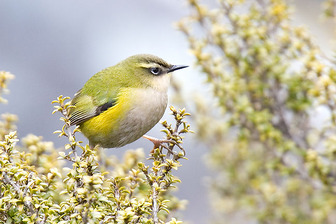South Island Wren
The Rockwren is the only surviving species in the genus Xenicus, and is thought to have been closely related to the formerly more widespread Bushwren. Like the Bushwren and the Rifleman it is a poor flier, rarely flying more than two metres off the ground or for distances or more than 30 m. It is highly terrestrial, feeding in low scrub and open scree and rockfalls in alpine areas.

Original source: originally posted to Flickr as Rock wren
Author: AndrewPermission(Reusing this file)This image, which was originally posted to Flickr.com, was uploaded to Commons using Flickr upload bot on 10:40, 14 June 2008 (UTC) by Kahuroa (talk). On that date it was licensed under the license below.This file is licensed under the Creative Commons Attribution 2.0 Generic license.You are free:to share – to copy, distribute and transmit the work
The South Island Wren is classified as Vulnerable (VU), considered to be facing a high risk of extinction in the wild.
The South Island wren is a small but robust alpine bird with a very short tail, rounded wings, and long legs and toes (2) (3). While the male’s plumage is a dull green colour above, grey-brown below and yellow on the flanks, the female is more olive-brown in colour. This charming bird has an unusual habit of vigorously bobbing up and down (3). More
South Island, while the South Island Wren is restricted to the alpine areas of South Island and is considered vulnerable. More
The South Island Wren is now restricted to South Island and is declining in numbers. The range of the Rifleman initially contracted with the felling of forests for agriculture but it has also expanded its range of habitats by moving into plantations of introduced exotic pines, principally the Monterey Pine. It also enters other human-modified habitat when it adjoins native forest. Like all New Zealand passerines the New Zealand wrens are sedentary, and are not thought to undertake any migrations. More
South Island Wren Xenicus gilviventris IUCN Red List Criteria Critically Endangered Endangered Vulnerable C1; C2a(i) IUCN Red List history Year Category 2008 Vulnerable 2005 Vulnerable 2004 Near Threatened 2000 Lower Risk/Near Threatened 1994 More
South Island Wren, Xenicus gilviventris Acanthisittidae (NEW ZEALAND WRENS) South Island Wren, Xenicus gilviventris This photo was taken in: New Zealand Notes on this photo: Also called Rock Wren, rare endemic, only in mountains, Homer Tunnel (NZ), Nov 2005 The photo was taken by: Georges Olioso New Zealand reports Birdwatching trip reports from New Zealand Birdtours.co. More
South Island Wren Xenicus gilviventris family links New Zealand Wrens - Xenicidae - http://www.eeb.cornell.edu/winkler/botw/xenicidae.html Family account... New Zealand Wrens - Acanthisittidae - http://en.wikipedia.org/wiki/Acanthisittidae The New Zealand wrens, Acanthisittidae, are a family of tiny passerines endemic to New Zealand. They are represented by six or seven known species in four or five genera, although only two species survive today... More
South Island Wren, Xenicus gilviventris post at birdsoftheworldonline.com/south-island-wren-x enicus-gilvi.... Thanks for a great photo of this interesting bird. Ron Posted 16 months ago. ( permalink ) view profile truubloo says: This is an amazing shot!!! Lovely colour and great detail! Wow well done :) Posted 15 months ago. More
South Island Wren Xenicus gilviventris South Island Wren Xenicus gilviventris Bird Group : Passeriformes - Passerines Bird Family : Acanthisittidae - NZ Wrens Bird Name : Xenicus gilviventris - South Island Wren Red Data Status : Near-threatened Bird Type : Unspecified Photographer : Aleix Comas Image Date : More

Original source: #if:29954808@N00|Andrew|#if:|
Author: #if:29954808@N00|Andrew|#if:|
Permission: Some rights reserved
Family : Acanthisittidae
Genus : Xenicus
Species : gilviventris
Authority : Pelzeln, 1867
